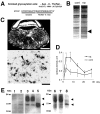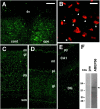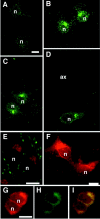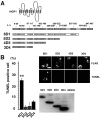Identification of an axotomy-induced glycosylated protein, AIGP1, possibly involved in cell death triggered by endoplasmic reticulum-Golgi stress
- PMID: 12486168
- PMCID: PMC6758406
- DOI: 10.1523/JNEUROSCI.22-24-10751.2002
Identification of an axotomy-induced glycosylated protein, AIGP1, possibly involved in cell death triggered by endoplasmic reticulum-Golgi stress
Abstract
We developed a new method, designated N-linked glycosylation signal (NGS) differential display (DD)-PCR, that enables the identification of genes encoding N-linked glycosylated molecules that exhibit varying patterns of expression. Using this innovative technique, we identified an N-linked glycosylated 11-transmembrane domain protein that is upregulated in response to axotomy. Expression levels increased 3 d after axotomy, reached maximal levels at approximately postoperative days 5-7, and then gradually decreased through day 20. The protein was termed axotomy-induced glycosylated/Golgi-complex protein 1 (AIGP1). AIGP1 immunoreactivity is specifically localized in neurons, with subcellular localization within the Golgi, indicating that AIGP1 is a resident Golgi protein. Moreover, AIGP1 gene expression in cultured neurons is specifically induced by the endoplasmic reticulum (ER)-Golgi stressors tunicamycin and brefeldin A. We observed that the frequency of cell death is increased by AIGP1 overexpression and that the corresponding region of the protein implicated in the activity involves the large eighth and ninth transmembrane loops. Our results suggest that AIGP1 gene activation and protein accumulation in the Golgi complex in response to axotomy-induced ER-Golgi stress may contribute to signaling during programmed cell death in damaged neurons.
Figures







Similar articles
-
Neurons overexpressing mutant presenilin-1 are more sensitive to apoptosis induced by endoplasmic reticulum-Golgi stress.J Neurosci Res. 2002 Aug 15;69(4):530-9. doi: 10.1002/jnr.10312. J Neurosci Res. 2002. PMID: 12210846
-
Alzheimer's disease-associated presenilin 1 in neuronal cells: evidence for localization to the endoplasmic reticulum-Golgi intermediate compartment.J Neurosci Res. 1997 Sep 15;49(6):719-31. doi: 10.1002/(SICI)1097-4547(19970915)49:6<719::AID-JNR6>3.0.CO;2-A. J Neurosci Res. 1997. PMID: 9335259
-
NRADD, a novel membrane protein with a death domain involved in mediating apoptosis in response to ER stress.Cell Death Differ. 2003 May;10(5):580-91. doi: 10.1038/sj.cdd.4401208. Cell Death Differ. 2003. PMID: 12728256
-
Nitric oxide-induced endoplasmic reticulum stress activates the expression of cargo receptor proteins and alters the glycoprotein transport to the Golgi complex.Int J Biochem Cell Biol. 2006;38(12):2040-8. doi: 10.1016/j.biocel.2006.05.016. Epub 2006 Jun 21. Int J Biochem Cell Biol. 2006. PMID: 16899390
-
Phospholipase D family member 4, a transmembrane glycoprotein with no phospholipase D activity, expression in spleen and early postnatal microglia.PLoS One. 2010 Nov 11;5(11):e13932. doi: 10.1371/journal.pone.0013932. PLoS One. 2010. PMID: 21085684 Free PMC article.
Cited by
-
Differential effects of unfolded protein response pathways on axon injury-induced death of retinal ganglion cells.Neuron. 2012 Feb 9;73(3):445-52. doi: 10.1016/j.neuron.2011.11.026. Neuron. 2012. PMID: 22325198 Free PMC article.
-
Retinal plasma extravasation in streptozotocin-diabetic rats mediated by kinin B(1) and B(2) receptors.Br J Pharmacol. 2008 May;154(1):136-43. doi: 10.1038/bjp.2008.48. Epub 2008 Mar 3. Br J Pharmacol. 2008. PMID: 18311190 Free PMC article.
-
ATF4 orchestrates a program of BH3-only protein expression in severe hypoxia.Mol Biol Rep. 2012 Dec;39(12):10811-22. doi: 10.1007/s11033-012-1975-3. Epub 2012 Oct 23. Mol Biol Rep. 2012. PMID: 23090478
-
Identification of p58IPK as a novel neuroprotective factor for retinal neurons.Invest Ophthalmol Vis Sci. 2015 Feb 5;56(2):1374-86. doi: 10.1167/iovs.14-15196. Invest Ophthalmol Vis Sci. 2015. PMID: 25655802 Free PMC article.
-
Solo/Trio8, a membrane-associated short isoform of Trio, modulates endosome dynamics and neurite elongation.Mol Cell Biol. 2006 Sep;26(18):6923-35. doi: 10.1128/MCB.02474-05. Mol Cell Biol. 2006. PMID: 16943433 Free PMC article.
References
-
- Abeijon C, Hirschberg CB. Topography of glycosylation reactions in the endoplasmic reticulum. Trends Biochem Sci. 1992;17:32–36. - PubMed
-
- Aoki K, Sun YJ, Aoki S, Wada K, Wada E. Cloning, expression and mapping of a gene that is upregulated in adipose tissue of mice deficient in bombesin receptor subtype-3. Biochem Biophys Res Commun. 2002;290:1282–1288. - PubMed
-
- Baba N, Koji T, Itoh M, Mizuno A. Reciprocal changes in the expression of Bcl-2 and Bax in hypoglossal nucleus after axotomy in adult rats: possible involvement in the induction of neuronal cell death. Brain Res. 1999;827:122–129. - PubMed
-
- Cameron AA, Cliffer KD, Dougherty PM, Willis WD, Carlton SM. Changes in lectin, GAP-43 and neuropeptide staining in the rat superficial dorsal horn following experimental peripheral neuropathy. Neurosci Lett. 1991;131:249–252. - PubMed
-
- Cockcroft S. Mammalian phosphatidylinositol transfer proteins: emerging roles in signal transduction and vesicular traffic. Chem Phys Lipids. 1999;98:23–33. - PubMed
Publication types
MeSH terms
Substances
LinkOut - more resources
Full Text Sources
Other Literature Sources
Molecular Biology Databases
Research Materials
